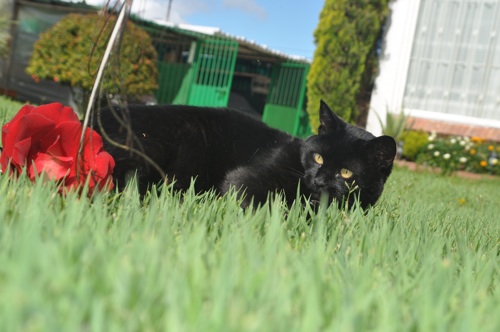There are many health benefits for your cat if you decide to keep her indoors. However, the transition may be difficult for her. Here are some suggestions to make your cat more comfortable.
Making your outdoor cat indoor-only
.jpg)
The decision to keep your cat indoors or allow her to go outside is a highly personal one. There are many potential health benefits to keeping your cat indoor-only including reduced risk for traumatic injury, infectious disease, and parasites. If you have decided to make your outdoor cat indoor-only, the following guidelines will help to ease the transition.
Set up a refuge with all of the resources the cat needs, food and water bowls, a perch (preferably near a window so that she can look outside), a place to sleep, hiding places (brown paper bags or cardboard boxes), a scratching post and toys. This will help your cat get used to you and the experience of being indoors. The refuge will be the cat's home for a while. Make sure that you visit often and leave a radio on while the cat is alone in the room.
If there are no other pets in the home then you may leave the door to the refuge open. If there are other pets please refer to the section on Introducing New Pets. Let the cat venture out when she ready. Keep all doors to the outside closed. The cat has been accustomed to being outdoors and may try to get back out. Try to make the indoor environment as interesting as possible. Place perches near windows so that the cat can look out. Perches should be two to three feet tall so the cat can look down on her surroundings. Provide scratching posts at several locations so the cat can exercise her instinct to scratch.
Set aside a play time each day. Use interactive toys such as laser pointers and feather teasers to play with the cat (find out what kind of toys your cat might prefer by visiting Identifying Your Cat's Prey Preference). When you are out, give the cat a choice of toys to play with. Change the toys every few days to keep the cat interested. Hide tasty treats around the house so the cat can hunt for them.
Despite your best efforts, your cat may still have a strong desire to escape to the outdoors. To discourage your cat from dashing out when doors are opened, you can try to make doors seem less appealing. Do this by spraying the cat with a water bottle or rattling a can of pennies if she goes too near an entry door. Citrus scent may also be sprayed on or near the door to keep the cat away. The goal is not to punish the cat but to associate the door with something unpleasant.
If you would like the cat to safely enjoy a little of the great outdoors you can train her to wear a harness and take her for leash walks or let her out onto a sun porch or screened enclosure.
Bringing a previously stray cat indoors
Stray cats are domestic cats who have been abandoned or have strayed from home and become lost. Strays have known human companionship and can usually be re-socialized and adopted successfully. A stray cat may be comfortable approaching you and allowing you to pet it and will return if food is left out. Feral cats are cats that have lived their whole life with little or no human contact. Adult feral cats avoid humans and cannot be re-socialized. They are more content living outdoors. Attempting to trap a cat that is feral presents a serious injury risk for inexperienced handlers. For more information on helping feral cats in your area please visit Alley Cat Allies.
 The first step in adopting a stray cat is to visit your veterinarian. Visit your vet before you bring the cat into contact with your family and pets. The cat should have a physical exam, be tested for feline leukemia and FIV, be vaccinated for feline distemper and rabies and be de-wormed. If the cat is intact it should be spayed or neutered. A thorough veterinary exam is important to protect your family and other animals in the household from infectious disease.
The first step in adopting a stray cat is to visit your veterinarian. Visit your vet before you bring the cat into contact with your family and pets. The cat should have a physical exam, be tested for feline leukemia and FIV, be vaccinated for feline distemper and rabies and be de-wormed. If the cat is intact it should be spayed or neutered. A thorough veterinary exam is important to protect your family and other animals in the household from infectious disease.
To introduce the new cat follow the same guidelines as those for making an outdoor cat indoor-only (see Making Your Outdoor Cat Indoor-Only). Be patient, and keep the cat happy and busy to help her to re-adjust to human companions and indoor living.
